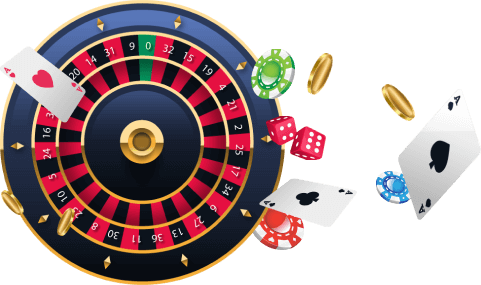Labouchere strategy for roulette
Henry Labouchere was a British politician and journalist who had a penchant for gambling. In particular, he loved to play roulette. Labouchere devised a roulette system that is still very popular today. The Labouchere system, which is also known as the cancellation system, American progression, and the split Martingale, is a negative progression betting system which means increasing the bet size following a loss.
Granted, the Labouchere system is a little more complicated than other systems that we have covered. Nevertheless, it's with learning about. We will now investigate the Labouchere system and find out if it’s effective and worthy of its popularity.
How the Labouchere System Works
One of the main differences between the Labouchere system, and most other betting strategies is that it attempts to recover losses gradually as opposed to all at once. The system works in cycles in which the player’s goal is to reach a predetermined profit margin. To implement this system, the player first decides how much money they want to win in a cycle. The next step is writing down a series of positive numbers that add up to the target amount. For example, if the target profit amount for a cycle is $6, then an appropriate progression would be 1, 2, and 3.
For each bet, the stake amount is equal to the sum of the first and last number on the list. So, if we are using 1, 2, and 3 as our starting progression, then we would open with a $4 wager (1+3). If the wager wins, then we remove the 1 and 3 from the list. If the bet loses, then the previous stake amount is added to the end of the list. In our scenario, our list of numbers would now be 1, 2, 3, and 4. If there is just one number remaining on the list, then that’s how much the bet will be. Once all numbers are crossed off, we will have met our target profit, and we can start a new cycle.
- All wagers are placed on even-money outside bets (Red/Black, High/Low, Even/Odd)
- Define a short-term goal. This is the amount you wish to win in a cycle.
- Create a list of positive numbers that adds up to the target profit amount.
- Our first bet will be equal to the first and last number on the list.
- If the bet wins, then we cross out the first and last numbers on the list.
- If the bet loses, then we add the losing wager amount to the end of the list.
- We keep playing until all numbers have been crossed out. We then start the cycle again.
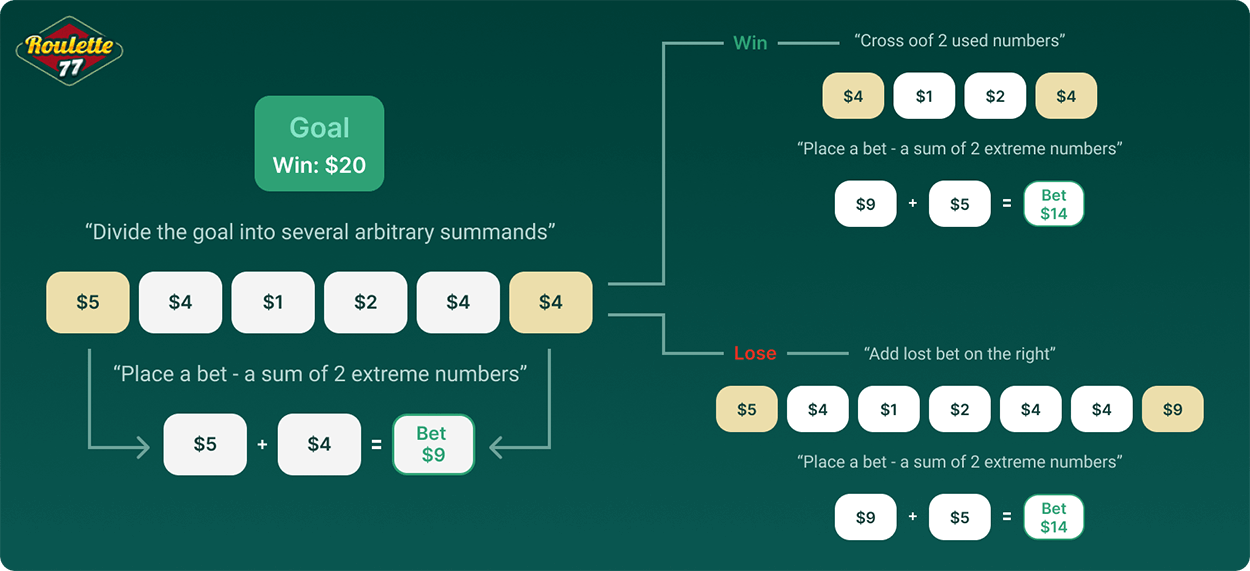
Let’s take a look at how the Labouchere system works in practice. We’ll see the progression over 5 fictitious spins. Of course, we start by coming up with a profit target and then jotting down the appropriate progression. For this illustration, we’ll set our goal at $10 and go with a progression of 1, 2, 3, 4. We will also stick to betting on Red/Black to keep things simple.
- Step 1
Our stake amount is equal to the first and last numbers on our list, which are 1 and 4. As such, we bet $5. It loses.
- Step 2
Because we lost $5 on the previous spin, we add a 5 to the end of our list of numbers. Our progression is now 1, 2, 3, 4, 5. This means we need to wager $6 (first and last numbers) on this round. This time we win.
- Step 3
After a win, we have to cross out the first and last numbers on our list. That leaves our progression at 2, 3, 4. Because the first and last numbers now equal 6, this will be our bet amount. This one loses.
- Step 4
After a loss, we add the losing stake amount to the end of the list, leaving us with 2, 3, 4, 6. This means we need to stake $8 (2+6) on this spin. It’s a winner!!
- Step 5
After deleting the 2 and 6 from the list, we are left with 3 and 4. Can you guess how much we wager on this spin? If you guessed $7, then you’re correct.
Putting the Labouchere System to the Test
To test the Labouchere system, our computer nerds used Java Script and the following parameters:
- 4 different players will play European roulette
- Each player starts with $1,000
- The simulation will run through 500 rounds
- Players 1 and 2 will set the target of each cycle at $10 with a 1, 2, 1, 3, 1, 1, 1 progression.
- Players 3 and 4 will set their targets at $15 with a 1, 3, 4, 4, 3 progression.
- The probabilities of winning and losing are 48.6% and 51.4%, respectively.
The following graph shows the results for Player 1.
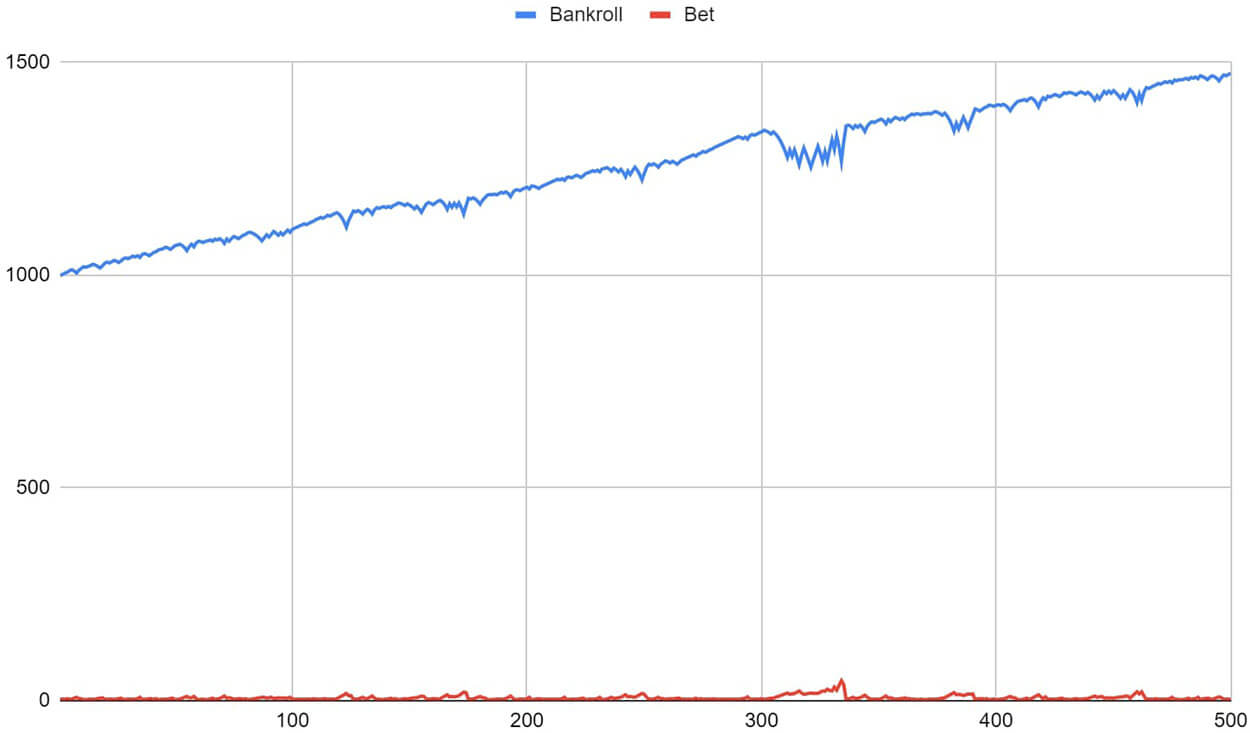
As the graph shows, Player 1 didn’t experience any sharp downturns. His max bet topped out at $46 and he went through 46 cycles which ended with a net gain of $474. The longest cycle lasted 35 rounds. Now, let’s see how Player 2 did.
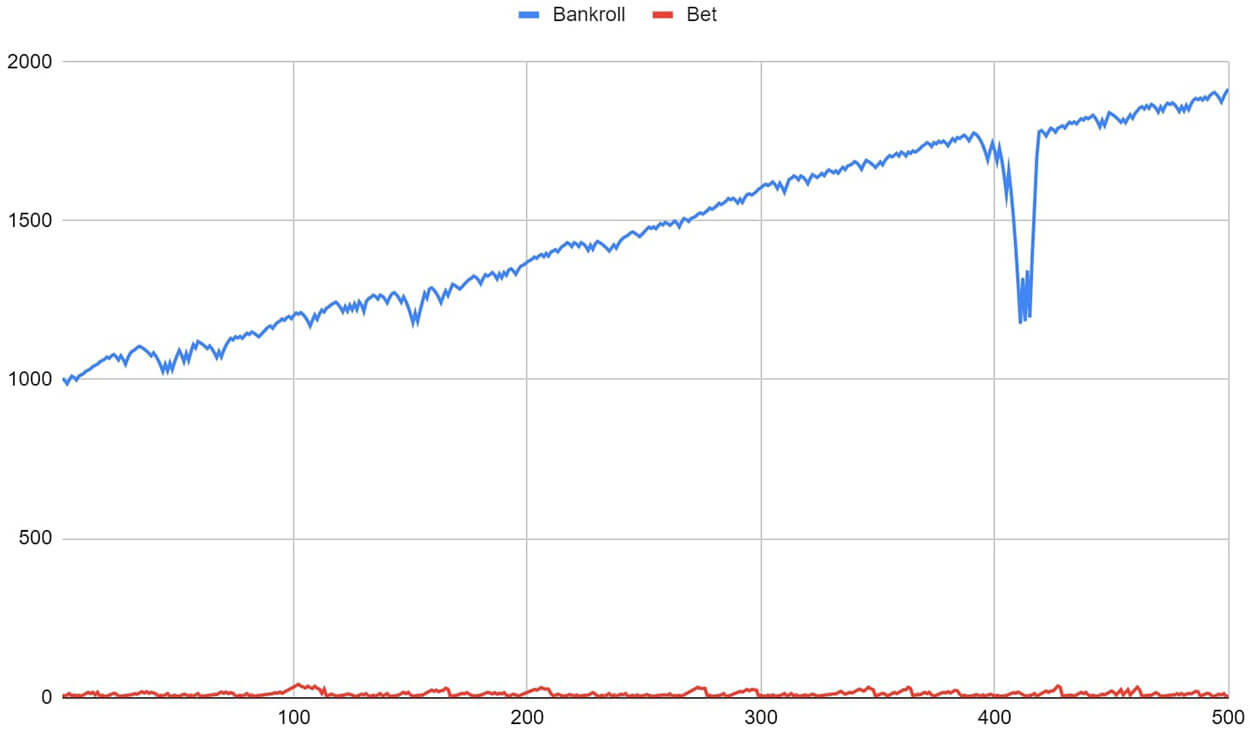
This simulation is a little more interesting. It went through 36 cycles with the longest one running for 59 turns. The biggest single bet was $199. As was the case with Player 1, this player ended the session with a tidy profit. On to Player 3.
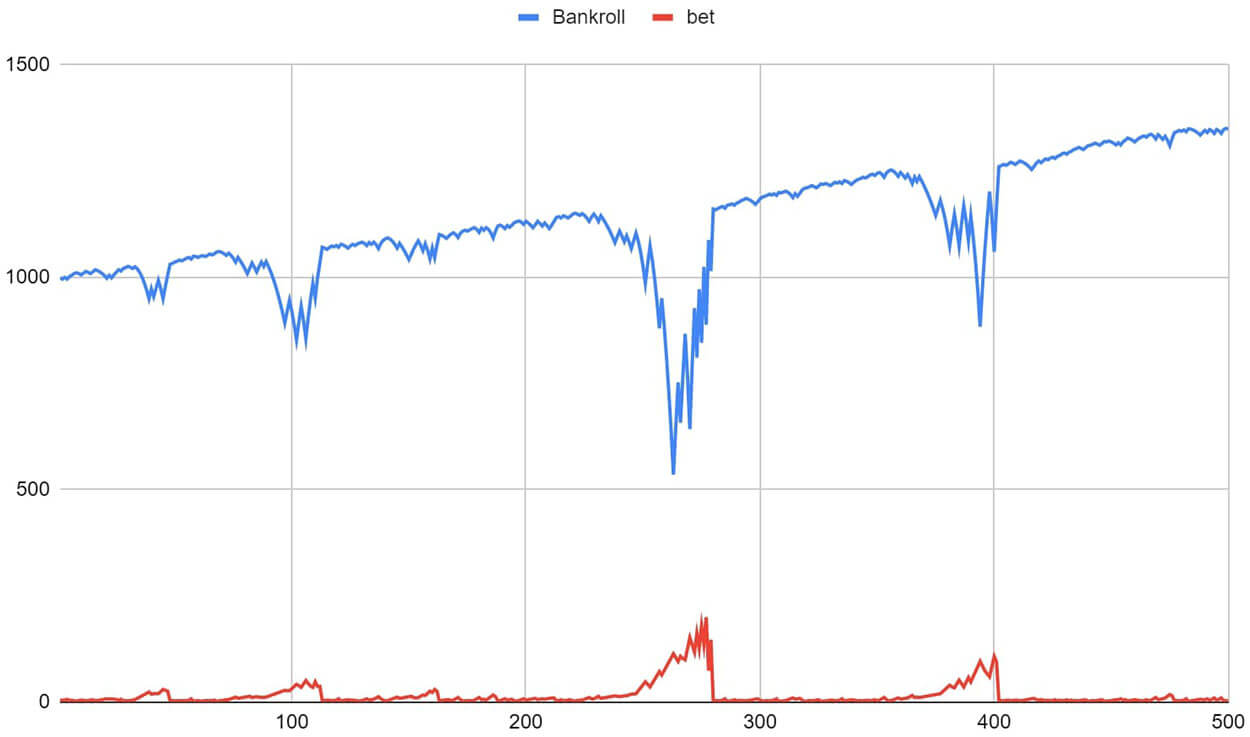
This situation was very similar to that of Player 1. Because the cycle target was $15 instead of $10, the bankroll grew faster. This player went through 56 cycles, with the longest one lasting 15 rounds. He reached a maximum stake amount of $41. So, how did Player 4 do? Let’s find out.
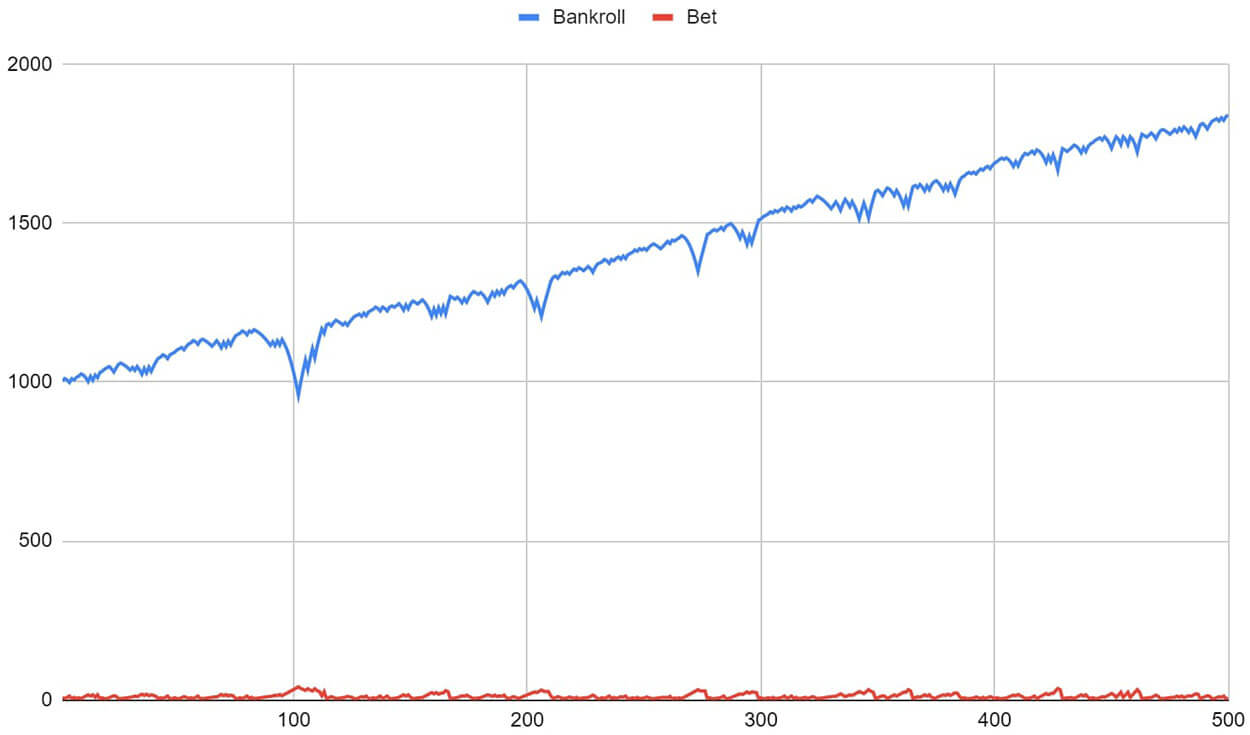
Player 4’s results are somewhat reminiscent of Player 2’s, mainly due to getting mired in a prolonged cycle at around the 400th turn. This cycle lasted 33 moves and reached a maximum bet of $160.
Pitfalls of Using the Labouchere System
In our test, the maximum iteration lengths for 3 and 4 players were 32 and 34 moves, respectively, and the drawdown peaks are radically different; what's the matter? The fact is that 3rd player at the peaks of the fall observed the following rows:
- 4,3,4,5,6,7,8,9,13,17,21
- 4,3,4,5,6,7,8,9,13,17,21,25
- 4,3,4,5,6,7,8,9,13,17,21,25,29
- 4,3,4,5,6,7,8,9,13,17,21,25,29,33
- 4,3,4,5,6,7,8,9,13,17,21,25,29,33,37
And for the fourth one:
- 16,24,36,48,64
- 16,24,36,48,64,80
- 16,24,36,48,64,80,96
- 16,24,36,48,64,80,96,112
- 16,24,36,48,64,80,96,112,128
As we can see, the fourth player simply has larger values of the terms. This means that the main pitfall is not only in the length of the iteration and the number of components, although their facts cannot be ruled out either.
However, I would not say that this strategy is very risky. Yes, there are moments of sharp subsidence. Limits on limits are unlikely to threaten here; we reached a maximum of $199. The bankroll can go down a lot, and there may not be enough money for the next bet, but again, the losses here do not grow progressively and having a good bankroll in reserve, you can easily compensate for the losses. Iteration may take a long time, but you will end your iteration sooner or later (not very long).
Also, here you need to be very careful and write down the rows separately for yourself and cross out the numbers since it is unrealistic to keep this in your mind. This can be problematic in a fast game like live roulette as there is little time to think.
Conclusion
Setting attainable and consistent goals is the key to success in roulette and most other forms of gambling. This is the very essence of the Labouchere roulette system.
By looking at the results of our simulations in graph form, it would be easy to think that the Labouchere system is strong. After all, each player ended the session with a profit. The lowest win was $348, and the biggest was $915. However, it should be noted that there were a few dangerous situations in which a large number of losses put the bankrolls at risk. Of course, these progressions were a lot less risky than Martingale.
While we can recommend this system, we also recommend that you go into it with a bankroll of at least 1,000 units. Using Labouchere might make the game more mechanical and less fun, but the algorithm is useful for meeting short-term goals if you don’t hit the skids for too long.
You can have a lot of fun experimenting with the Labouchere roulette system. You can tinker with the progressions and use them on any even-money bet. The bigger the goal, the faster your bankroll will grow. Well, in theory, anyway.
Your new strategy is waiting to be tested - play roulette for real!
-
1
 Wild Casino
Wild CasinoAccepts US players
Bonus 100% up to $5 000Wagering requirement x25Roulette games 10+Live dealerPayments -
-
2
 DuckyLuck
DuckyLuckAccepts US players
Bonus 500% up to $2 500Wagering requirement x30Roulette games 5Live dealerPayments -
-
3
 Jackbit Casino
Jackbit CasinoAccepts US players
Rakeback up to 30%+ 100 FreespinsWagering requirement x1Roulette games 40+Live dealerPayments -
-
4
 BetUS
BetUSAccepts US players
Bonus 100% up to $3 000Wagering requirement x30Roulette games 10+Live dealerPayments -
-
5
 Ignition Casino
Ignition CasinoAccepts US players
Bonus 100% up to $2 000Wagering requirement x25Roulette games 10+Live dealerPayments -
-
6
 BetOnline
BetOnlineAccepts US players
Bonus 100% up to $1 000Wagering requirement x30Roulette games 10+Live dealerPayments -
-
7
 SlotoCash
SlotoCashAccepts US players
Bonus 100% up to $1 000Wagering requirement x25Roulette games 5+Live dealerPayments -
-
8
 BoVegas
BoVegasAccepts US players
Bonus 100% up to $5 500Wagering requirement x60Roulette games 5+Live dealerPayments -
-
9
 Coinsgame
CoinsgameAccepts US players
Bonus 180% up to $20 000Wagering requirement x20Roulette games 10+Live dealerPayments -
-
10
 SlotsEmpire
SlotsEmpireAccepts US players
Bonus 245% Welcome offerWagering requirement x35Roulette games 5+Live dealerPayments -
-
11
 BC.Game
BC.GameAccepts US players
Bonus 180% up to $20 000Wagering requirement x40Roulette games 20+Live dealerPayments -
-
12
 Red Dog
Red DogAccepts US players
225% welcome bonus code: WAGGINGTAILSWagering requirement x35Roulette games 5+Live dealerPayments -
-
13
 Golden Lion
Golden LionAccepts US players
$75 Roulette Match code: TALISMAN75Wagering requirement x60Roulette games 5+Live dealerPayments -
-
14
 El Royale
El RoyaleAccepts US players
260% welcome bonus code: TRUEROYALWagering requirement x35Roulette games 5+Live dealerPayments -
Check out recommended articles for you
- Martingale Strategy
- Reverse Martingale
- Grand Martingale
- d'Alembert system
- Fibonacci system
- Romanovsky
- 666 system
- 36 system
- Oscar's Grind System
- Fisher system
- Contra Bet System
- 4567 system
- $150 system
- 24+8 system
- 64% system
- Hollandish system
- Tier et Tout
- Masse Egale
- Shotwell
- James Bond
- Safe strategies
- Strategies for american roulette
- Small Bankroll Strategies
- Live Roulette Strategies























